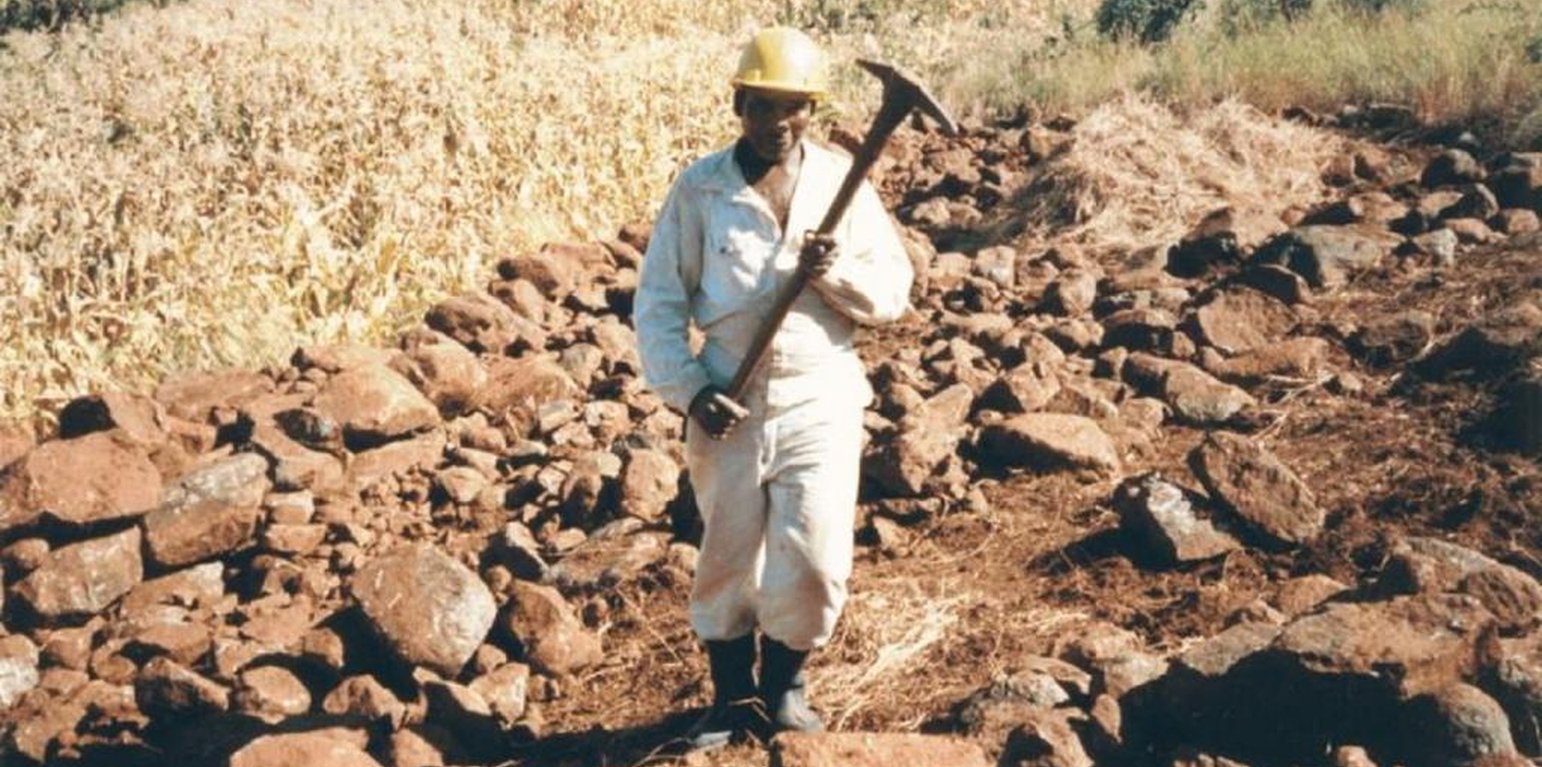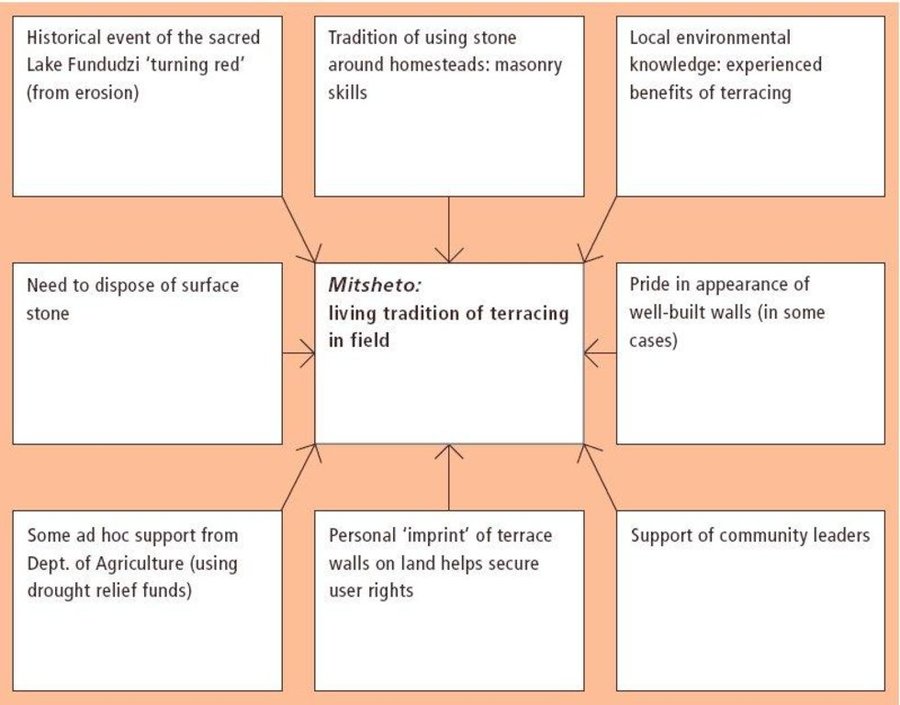Community tradition
(Өмнөд Африк)
Тодорхойлолт
Inherited, and still practiced, tradition of stone terracing - passed down from generation to generation.
Aims / objectives: The VhaVenda people of Limpopo Province in South Africa have a tradition of building with stone which has been passed down from generation to generation. They construct stone walls around their houses for example, taking a pride in the appearance of their homesteads. There is a historical monument nearby, the stone-built kraal at Dzata, the ruins of which are situated within a few kilometres of the study location. There may even be some evidence that the VhaVenda came originally from the area of the Great Zimbabwe (the famous stone-built fortress in Zimbabwe). It is not surprising therefore that the VhaVenda have used their masonry skills to build terraces in fields to counter erosion and simultaneously to make cultivation - along the contour by oxen - possible. This tradition has been passed down through the ages: it is institutionalised in the community and is practised together by men, women and children on a family basis. It is encouraged by community leaders: a particular example of this was in the 1960s when local chiefs were concerned at the sacred Lake Fundudzi 'turning red' - with sediment eroded from the land - and as a result they launched a conservation campaign to prevent soil wash into the lake. There has been modest and occasional support by the Department of Agriculture, in the form of ad hoc drought relief funds. There is quite a range of technical ability/care taken in terracing. Some walls are meticulously built; others are merely piles of stone across the slope. One of the reasons for this is that work tends to be done on an individual basis. Another result is that fields may take two years or more to be fully terraced. What is evident is that the land users - as well as being experienced masons -appreciate the benefits of the terraces they construct. An investigation of local environmental knowledge and conservation practices has demonstrated this clearly (see reference).
Methods: The causes of erosion were explained by the interviewees as being part natural (rainfall, slope etc) and part anthropogenic (poor road building, up and down ploughing, burning of grassland etc). The main negative impact of erosion was considered to be loss of soil fertility: hence terracing for protection. This indigenous knowledge also extends to soils: eight local soil types and their differences in terms of texture, fertility and erodibility are recognised in the study area.
Байршил
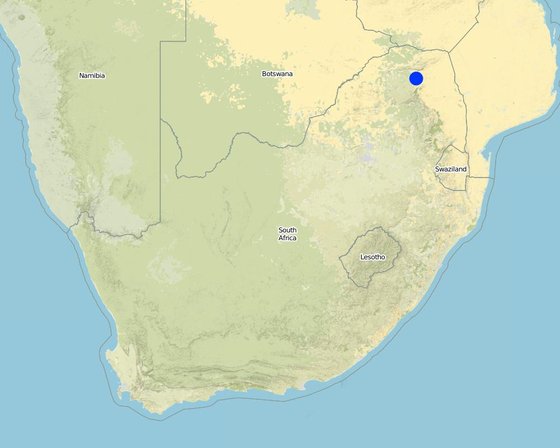
Байршил: Limpopo Province, Өмнөд Африк
Сонгосон байршлуудын газарзүйн холболт
Эхлэх огноо: тодорхойгүй
Төгсөх жил: тодорхойгүй
Арга барилын төрөл
-
уламжлалт / уугуул
-
Сүүлийн үеийн орон нутгийн санаачлага / шинэчлэл
-
төсөл / хөтөлбөр дээр үндэслэсэн
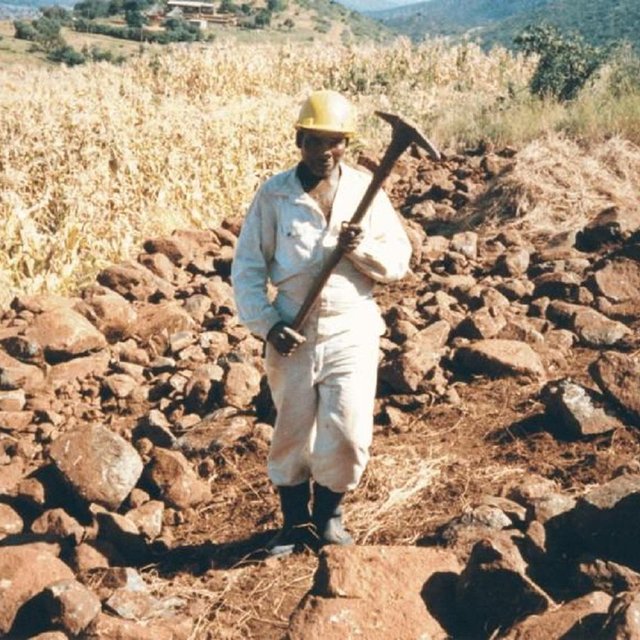
A retired miner, Elias, expanding his field and making new terrace walls as he proceeds: at this stage the stones are loosely arranged before construction of the walls takes place.
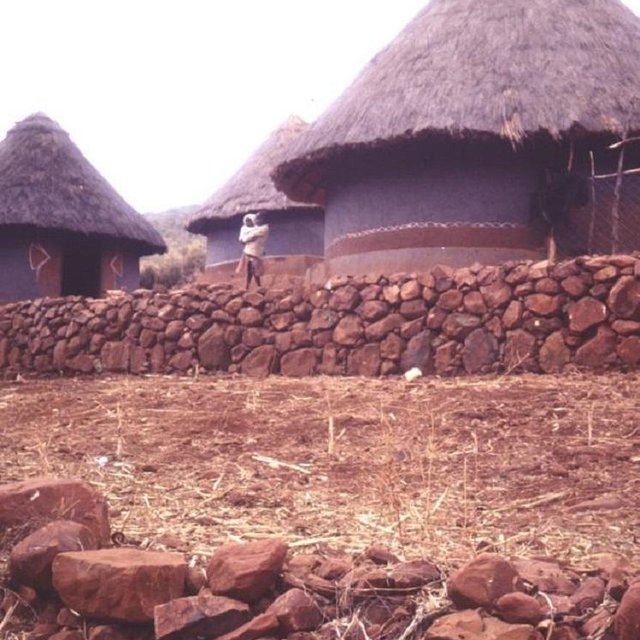
Masonry skills are employed to build the houses (which are then plastered over) and to construct stone walls around the homesteads.
Арга барилын зорилго ба эерэг нөлөө
Арга барилын үндсэн зорилго, зорилт
The objective of the local people is simply to continue making cultivation possible and sustainable, through the local tradition of using stone walls to create terraces and to remove abundant stones from the field.
The SLM Approach addressed the following problems: - the tradition presumably arose as a spontaneous local response to degradation: it remains well entrenched - underlying problems of no flat land to cultivate, soil erosion/fertility decline on sloping fields, and loose stone and rocks impeding animal-draw ploughs
Тухайн Арга барилын хүрээнд нэвтрүүлсэн Технологийг хэрэгжүүлэхэд дэмжлэг болох нөхцлүүд
Тухайн Арга барилын хүрээнд нэвтрүүлсэн Технологийг хэрэгжүүлэхэд хүндрэл учруулах нөхцлүүд
-
Бусад: labour: High labour demand to remove stone from inhibiting cultivation.
Treatment through the SLM Approach: Traditional teaching that such stone can be used constructively to improve conservation and yield benefits.
Талуудын оролцоо ба үүрэг
Арга барилд оролцогч талууд болон тэдгээрийн үүрэг
| Ямар оролцогч талууд / хэрэгжүүлэгч байгууллагууд арга барилд оролцож байсан бэ? |
Оролцогч талуудыг тодорхойлно уу |
Оролцогч талуудын үүргийг тайлбарлана уу |
| Орон нутгийн газар ашиглагч / орон нутгийн иргэд |
|
|
Арга барилын янз бүрийн үе шатанд орон нутгийн газар ашиглагчид / бүлгүүдийг татан оролцуулах
үгүй
идэвхигүй
Гадаад дэмжлэг
интерактив
өөрийн хүчийг нэгтгэсэн
санаачлага/идэвхжүүлэлт
passing on knowledge; passing on of knowledge from generation to generation
Хэрэгжилт
family-based (or individual) construction
Арга барил хэрэгжүүлэх бүдүүвч
Enabling environment: Factors supporting the terracing tradition
ГТМ-ийн технологи сонгох шийдвэр гаргах явц
Шийдвэр гаргасан этгээд
-
Газар ашиглагч дангаараа (өөрийн санаачлага)
-
ГТМ-ийн мэргэжилтнүүдийн дэмжлэгтэйгээр, голчлон газар ашиглагчид
-
оролцооны зарчмын хэсэг болох бүх холбогдох талууд
-
голдуу ГТМ-ийн мэргэжилтнүүд, газар ашиглагчидтай зөвлөлдсөний үндсэн дээр
-
ГТМ-ийн мэргэжилтэн дангаараа
-
улс төрчид / удирдагчид
Шийдвэр гаргах үндэслэл нь
-
ГТМ-ийн мэдлэгийг баримтжуулалтын үнэлгээ (нотолгоонд суурилсан шийдвэр гаргах)
-
Судалгааны үр дүн, ололтууд
-
Хувь хүний туршлага ба санал бодол (баримтжуулаагүй)
Техникийн туслалцаа, чадавхи бий болгох болон мэдлэгийн менежмент
Дараах үйл ажиллагаа эсвэл үйлчилгээ нь арга барилын нэг хэсэг болсон
-
Чадавхи бэхжүүлэх/сургалт
-
Зөвлөх үйлчилгээ
-
Институцийг бэхжүүлэх (байгууллагын хөгжил)
-
Мониторинг ба үнэлгээ
-
Судалгаа
Чадавхи бэхжүүлэх / сургалт
Дараах сонирхогч талуудад сургалт хийсэн
-
Газар ашиглагчид
-
хээрийн ажилтан / зөвлөх
Сургалтын хэлбэр
-
Ажил дээр
-
фермерээс -фермер
-
үзүүлэнгийн талбай
-
Олон нийтийн уулзалт
-
курс дамжаа
Хамарсан сэдэв
There was/is no formal training - just father to son/mother to daughter.
Зөвлөх үйлчилгээ
Зөвлөх үйлчилгээ үзүүлсэн
-
Газар ашиглагчийн талбай дээр
-
Тогтмол төвд
Key elements: Some encouragement from Department of Agriculture especially during soil and water conservation campaigns/drought relief periods.
Институцийг бэхжүүлэх
Институци бэхжисэн / бий болсон
-
Үгүй
-
Тийм, бага
-
Тийм, дунд зэрэг
-
Тийм, маш их
дараах түвшинд
-
Орон нутгийн
-
Бүс нутгийн
-
Үндэсний
Байгууллага, үүрэг, хариуцлага, гишүүд зэргийг тодорхойлно уу.
Дэмжлэгийн төрөл
-
Санхүүгийн
-
чадавхи бэхжүүлэх / сургалт
-
Тоног төхөөрөмж
Дэлгэрэнгүй мэдээлэл
support for SWC campaigns from local leaders
Мониторинг ба үнэлгээ
bio-physical aspects were ad hoc monitored through observations
technical aspects were ad hoc monitored through observations; indicators
economic / production aspects were ad hoc monitored through observations
area treated aspects were ad hoc monitored through observations
There were no changes in the Approach as a result of monitoring and evaluation
Санхүүжилт болон хөндлөнгийн материаллаг дэмжлэг
ГТМ-ийн бүрэлдэхүүн хэсгийн жилийн төсөв ам.доллараар
-
< 2,000
-
2,000-10,000
-
10,000-100,000
-
100,000-1,000,000
-
> 1,000,000
Precise annual budget: тодорхойгүй
Approach costs were met by the following donors: government (national): 5.0%; local community / land user(s) (-): 95.0%
Газар ашиглагч нарт дараах урамшуулал, үйлчилгээг үзүүлсэн
-
Газар ашиглагчдад санхүүгийн / материаллаг дэмжлэг үзүүлсэн
-
Тодорхой хөрөнгө оруулалтанд нөхөн олговор олгох
-
Кредит
-
Бусад урамшуулал, хэрэгсэл
Нөлөөллийн дүн шинжилгээ ба дүгнэлт
Арга барилын үр нөлөө
Үгүй
Тийм, бага зэрэг
Тийм, зарим
Тийм, их
Арга барил нь ГТМ-ийн технологийг хэрэгжүүлж, хадгалахад газар ашиглагчдад тусласан уу?
Great: as part and parcel of the local tradition - for example contour ploughing is facilitated by the fact that the stone lines are on the contour, making this type of ploughing easier.
Did other land users / projects adopt the Approach?
Only within this small pocket of Thohoyandou District (as far as known).
Газар ашиглагчид ГТМ хэрэгжүүлэх болсон үндсэн шалтгаан
Арга барилын хүрээнд хэрэгжүүлсэн үйл ажиллагааны тогтвортой байдал
Газар ашиглагчид арга барилаар дамжуулан хэрэгжүүлсэн арга хэмжээг тогтвортой үргэлжлүүлж чадах уу (гадны дэмжлэггүйгээр)?
The VhaVenda have built terraces for generations so far, so no reason to think that things will change.
Дүгнэлт, сургамж
Давуу тал: газар ашиглагчийн бодлоор
Давуу тал: эмхэтгэгч эсвэл бусад мэдээлэл өгсөн хүмүүсийн бодлоор
-
Traditional approaches have the potential to endure (How to sustain/ enhance this strength: Acknowledgement and encouragement by the Government and/or NGOs will help this.)
Сул тал/ дутагдал / эрсдэл: газар ашиглагчийн бодлоордаван туулах боломжууд
Сул тал/ дутагдал / эрсдэл: эмхэтгэгч эсвэл бусад мэдээлэл өгсөн хүмүүсийн бодлоордаван туулах боломжууд
-
This tradition was largely unrecognised until recently: therefore an opportunity was lost to encourage people and help the approach spread
Publicise widely and carry out farmer-to-farmer/community-to-community visits to further its spread and the spread of local SWC knowledge more generally.
Суурь мэдээлэлүүд
Хянагч
-
Fabian Ottiger
-
Deborah Niggli
Баримтжуулсан огноо: 15 1-р сар 2009
Сүүлийн шинэчлэл: 04 4-р сар 2018
Мэдээлэл өгсөн хүн
-
William Critchley (williamcritchley01@gmail.com) - ГТМ мэргэжилтэн
-
Rinda Van der Merwe (rinda@arc.agric.za) - ГТМ мэргэжилтэн
WOCAT мэдээллийн сан дахь бүрэн тодорхойлолт
Баримтжуулалтыг зохион байгуулсан
Байгууллага
- Institute for Soil, Climate & Water - Өмнөд Африк
Төсөл
- Book project: where the land is greener - Case Studies and Analysis of Soil and Water Conservation Initiatives Worldwide (where the land is greener)
Гол сурвалж баримт сэлт
-
Critchley W and Netshikhovehla E (1998) Conventional views, changing paradigms and a tradition of soil conservation.:
